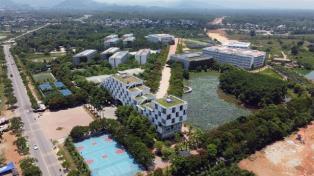Việt Nam must strive to independently manufacture semiconductor chips by 2027: PM
Key ongoing projects include initiatives for specialised chip development, the electronics industry, talent attraction and foreign investment in semiconductors.

HÀ NỘI - Prime Minister Phạm Minh Chính on Monday set a target for the semiconductor sector to be capable of independently designing, manufacturing and testing key semiconductor chips by no later than 2027.
He was speaking at the second session of the National Steering Committee on Semiconductor Industry Development in Hà Nội.
The meeting was virtually connected with authorities from provinces and cities, universities, high-tech zones and other stakeholders to review the implementation of Việt Nam’s Semiconductor Industry Development Strategy and Human Resources Development Programme through 2030, with a vision to 2050.
The strategy outlines 38 projects and tasks assigned to 10 ministries.
So far, 10 have been completed on schedule, 24 are underway, and four have yet to commence.
Key ongoing projects include initiatives for specialised chip development, the electronics industry, talent attraction and foreign investment in semiconductors, according to reports at the event.
Ten months after the strategy’s launch, ministries and localities have actively developed legal frameworks, policies and plans while promoting an ecosystem conducive to achieving the strategy's Phase 1 targets. The human resources programme has seen nine of 34 tasks completed, while 25 remain in progress, many of which are scheduled annually and not yet due.
Infrastructure development includes expanding Vietnamese-owned chip production facilities and building international-standard cleanroom labs in major cities.
To date, Việt Nam has attracted 170 FDI projects in the semiconductor and high-tech industries, with total registered capital nearing US$11.6 billion.
Nearly 50 foreign corporations and more than 10 Vietnamese companies are engaged in chip design.
There are fourteen foreign and one domestic enterprise in packaging and testing and 15 foreign firms in support industries across the country.
Việt Nam has also been selected as one of around 10 countries to partner with the Global Semiconductor Alliance in hosting the world’s largest semiconductor event series.
PM Chính said semiconductor chips would play a key role in the fourth industrial revolution, especially in serving databases and AI. Việt Nam could not stand out from this rapidly emerging trend.
He highly appreciated the efforts of ministries, sectors, localities, training institutions and businesses in advancing Việt Nam’s semiconductor industry.
These efforts had contributed to creating new growth drivers for the economy and breakthroughs in science, technology, innovation and national digital transformation, he said.
He also pointed out several challenges, including capital investment demands, institutional and infrastructure development, technology transfer, human resource training and coordination and linkage in the development of the semiconductor industry.
The PM emphasised the need to develop a comprehensive, synchronised, inclusive, practical and effective semiconductor industry ecosystem.
He also called for improving the legal and policy frameworks, particularly preferential mechanisms and policies, to address bottlenecks in infrastructure, institutions, and human resources.
The Government leader urged a shift from incentive policies focused solely on investment attraction to those promoting technology transfer. There must be close and effective coordination among the “three pillars”: the Government, enterprises, and academia, to link development facilitation with research and production.
The Ministry of Finance was tasked with accelerating the implementation of human resource development plans and enhancing FDI attraction, particularly for advanced, clean, high-tech projects with strong global linkages.
Within this year, the ministry must propose a credit programme for students pursuing science, technology, engineering and mathematics (STEM).
The Ministry of Science and Technology would oversee progress to meet strategic goals and ensure alignment with long-term targets.
The Ministry of Foreign Affairs would be responsible for facilitating international cooperation and mobilising resources for training and industry development, including updating a database of overseas Vietnamese semiconductor experts.
The Ministry of Industry and Trade would be in charge of working with the US to remove Việt Nam from its strategic export control list to create favourable conditions to approach advanced US technology and promote cooperation between high-tech and semiconductor enterprises of the two countries.
He concluded the meeting by affirming that semiconductor development would be a vital trend and a key task in the coming time, calling it “a task that needs to be done, must be completed with determination” and would require support from people, the business community, investors and international partners. VNS



